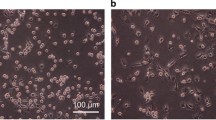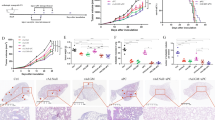Abstract
Apelin/APJ axis plays a critical role in cancer progression, thus its targeting inhibits tumor growth. However, blocking of Apelin/APJ axis in combination with immunotherapeutic approaches may be more effective. This study aimed to investigate the effects of APJ antagonist ML221 in combination with a DC vaccine on angiogenic, metastatic and apoptotic-related factors in a breast cancer (BC) model. Four groups of female BALB/c mice with 4T1-induced BC were treated with PBS, APJ antagonist ML221, DC vaccine, and “ML221 + DC vaccine”. After completion of the treatment, the mice were sacrificed and the serum levels of IL-9 and IL-35 as well as the mRNA expression of angiogenesis (including VEGF, FGF-2, and TGF-β), metastasis (including MMP-2, MMP-9, CXCR4) and apoptosis-related markers (Bcl-2, Bax, Caspase-3) in tumor tissues were determined using ELISA and real-time PCR, respectively. Angiogenesis was also evaluated by co-immunostaining of tumor tissues with CD31 and DAPI. Primary tumor metastasis to the liver was analyzed using hematoxylin–eosin staining. The efficiency of combination therapy with “ML221 + DC vaccine” was remarkably higher than single therapies in preventing liver metastasis compared to the control group. In comparison with the control group, combination therapy could significantly reduce the expression of MMP-2, MMP-9, CXCR4, VEGF, FGF-2, and TGF-β in tumor tissues (P < 0.05). It also decreased the serum level of IL-9 and IL-35 compared with the control group (P < 0.0001). Moreover, vascular density and vessel diameter were significantly reduced in the combination therapy group compared with the control group (P < 0.0001). Overall, our findings demonstrate that combination therapy using a blocker of the apelin/APJ axis and DC vaccine can be considered a promising therapeutic program in cancers.
Graphical Abstract







Similar content being viewed by others
References
Sung H, Ferlay J, Siegel RL, Laversanne M, Soerjomataram I, Jemal A, et al. Global Cancer Statistics 2020: GLOBOCAN estimates of incidence and mortality worldwide for 36 cancers in 185 countries. CA Cancer J Clin. 2021;71(3):209–49.
Peart O. Metastatic breast cancer. Radiol Technol. 2017;88(5):519m-m539.
Emens LA. Breast cancer immunotherapy: facts and hopes. Clin Cancer Res. 2018;24(3):511–20.
Hegde S, Krisnawan VE, Herzog BH, Zuo C, Breden MA, Knolhoff BL, et al. Dendritic cell paucity leads to dysfunctional immune surveillance in pancreatic cancer. Cancer Cell. 2020;37(3):289-307.e9.
Wang Y, Xiang Y, Xin VW, Wang XW, Peng XC, Liu XQ, et al. Dendritic cell biology and its role in tumor immunotherapy. J Hematol Oncol. 2020;13(1):107.
Saxena M, Bhardwaj N. Re-emergence of dendritic cell vaccines for cancer treatment. Trends Cancer. 2018;4(2):119–37.
van Willigen WW, Bloemendal M, Gerritsen WR, Schreibelt G, de Vries IJM, Bol KF. Dendritic cell cancer therapy: vaccinating the right patient at the right time. Front Immunol. 2018;9:2265.
Fares J, Fares MY, Khachfe HH, Salhab HA, Fares Y. Molecular principles of metastasis: a hallmark of cancer revisited. Signal Transduct Target Ther. 2020;5(1):28.
Hao L, Zhang C, Qiu Y, Wang L, Luo Y, Jin M, et al. Recombination of CXCR4, VEGF, and MMP-9 predicting lymph node metastasis in human breast cancer. Cancer Lett. 2007;253(1):34–42.
Teleanu RI, Chircov C, Grumezescu AM, Teleanu DM. Tumor angiogenesis and anti-angiogenic strategies for cancer treatment. J Clin Med. 2019;9(1):84.
Lugano R, Ramachandran M, Dimberg A. Tumor angiogenesis: causes, consequences, challenges and opportunities. Cell Mol Life Sci. 2020;77(9):1745–70.
He J, Wang L, Zhang C, Shen W, Zhang Y, Liu T, et al. Interleukin-9 promotes tumorigenesis through augmenting angiogenesis in non-small cell lung cancer. Int Immunopharmacol. 2019;75:105766.
Lu D, Qin Q, Lei R, Hu B, Qin S. Targeted blockade of interleukin 9 inhibits tumor growth in murine model of pancreatic cancer. Adv Clin Exp Med. 2019;28(10):1285–92.
Cai L, Zhang Y, Zhang Y, Chen H, Hu J. Effect of Th9/IL-9 on the growth of gastric cancer in nude mice. Onco Targets Ther. 2019;12:2225–34.
Wang Z, Liu JQ, Liu Z, Shen R, Zhang G, Xu J, et al. Tumor-derived IL-35 promotes tumor growth by enhancing myeloid cell accumulation and angiogenesis. J Immunol. 2013;190(5):2415–23.
Gan W, Zhang M-X, Huang J-L, Zhou P-Y, Zhou C, Liu G, et al. Interleukin 35 activates intratumor neovascularization via enhanced secretion of FGF2 in hepatocellular carcinoma through the recruitment of neutrophils, and blocking it could facilitate the efficacy of the PD-1 antibody. Res Square. 2020. https://doi.org/10.21203/rs.3.rs-130889/v1.
Fulda S. Tumor resistance to apoptosis. Int J Cancer. 2009;124(3):511–5.
Tatemoto K, Hosoya M, Habata Y, Fujii R, Kakegawa T, Zou MX, et al. Isolation and characterization of a novel endogenous peptide ligand for the human APJ receptor. Biochem Biophys Res Commun. 1998;251(2):471–6.
Masoumi J, Jafarzadeh A, Khorramdelazad H, Abbasloui M, Abdolalizadeh J, Jamali N. Role of Apelin/APJ axis in cancer development and progression. Adv Med Sci. 2020;65(1):202–13.
Antushevich H, Wójcik M. Review: Apelin in disease. Clin Chim Acta. 2018;483:241–8.
Castan-Laurell I, Masri B, Valet P. The apelin/APJ system as a therapeutic target in metabolic diseases. Expert Opin Ther Targets. 2019;23(3):215–25.
Habata Y, Fujii R, Hosoya M, Fukusumi S, Kawamata Y, Hinuma S, et al. Apelin, the natural ligand of the orphan receptor APJ, is abundantly secreted in the colostrum. Biochim Biophys Acta. 1999;1452(1):25–35.
Leeper NJ, Tedesco MM, Kojima Y, Schultz GM, Kundu RK, Ashley EA, et al. Apelin prevents aortic aneurysm formation by inhibiting macrophage inflammation. Am J Physiol Heart Circ Physiol. 2009;296(5):H1329–35.
Luo Q, Liu G, Chen G, Guo D, Xu L, Hang M, et al. Apelin protects against sepsis-induced cardiomyopathy by inhibiting the TLR4 and NLRP3 signaling pathways. Int J Mol Med. 2018;42(2):1161–7.
Uribesalgo I, Hoffmann D, Zhang Y, Kavirayani A, Lazovic J, Berta J, et al. Apelin inhibition prevents resistance and metastasis associated with anti-angiogenic therapy. EMBO Mol Med. 2019;11(8):e9266.
Berta J, Kenessey I, Dobos J, Tovari J, Klepetko W, Jan Ankersmit H, et al. Apelin expression in human non-small cell lung cancer: role in angiogenesis and prognosis. J Thorac Oncol. 2010;5(8):1120–9.
Hall C, Ehrlich L, Venter J, O’Brien A, White T, Zhou T, et al. Inhibition of the apelin/apelin receptor axis decreases cholangiocarcinoma growth. Cancer Lett. 2017;386:179–88.
Muto J, Shirabe K, Yoshizumi T, Ikegami T, Aishima S, Ishigami K, et al. The apelin-APJ system induces tumor arteriogenesis in hepatocellular carcinoma. Anticancer Res. 2014;34(10):5313–20.
Frisch A, Kälin S, Monk R, Radke J, Heppner FL, Kälin RE. Apelin controls angiogenesis-dependent glioblastoma growth. Int J Mol Sci. 2020;21(11):4179.
Podgórska M, Pietraszek-Gremplewicz K, Nowak D. Apelin effects migration and invasion abilities of colon cancer cells. Cells. 2018;7(8):113.
Hao YZ, Li ML, Ning FL, Wang XW. APJ Is associated with treatment response in gastric cancer patients receiving concurrent chemoradiotherapy and endostar therapy. Cancer Biother Radiopharm. 2017;32(4):133–8.
Berta J, Török S, Tárnoki-Zách J, Drozdovszky O, Tóvári J, Paku S, et al. Apelin promotes blood and lymph vessel formation and the growth of melanoma lung metastasis. Sci Rep. 2021;11(1):5798.
Picault FX, Chaves-Almagro C, Projetti F, Prats H, Masri B, Audigier Y. Tumour co-expression of apelin and its receptor is the basis of an autocrine loop involved in the growth of colon adenocarcinomas. Eur J Cancer. 2014;50(3):663–74.
Tian L, Liu H-Z, Zhang Q, Geng D-Z, Yang J, Geng H-T, et al. Regulation of apelin is associated with proliferation and angiogenesis in gastric cancer. Res Square. 2020. https://doi.org/10.21203/rs.3.rs-104563/v1.
Harford-Wright E, Andre-Gregoire G, Jacobs KA, Treps L, Le Gonidec S, Leclair HM, et al. Pharmacological targeting of apelin impairs glioblastoma growth. Brain. 2017;140(11):2939–54.
Inaba K, Inaba M, Romani N, Aya H, Deguchi M, Ikehara S, et al. Generation of large numbers of dendritic cells from mouse bone marrow cultures supplemented with granulocyte/macrophage colony-stimulating factor. J Exp Med. 1992;176(6):1693–702.
Masoumi J, et al. Inhibition of apelin/APJ axis enhances the potential of dendritic cell-based vaccination to modulate TH1 and TH2 cell-related immune responses in an animal model of metastatic breast cancer. Adv Med Sci. 2022;67(1):170–8.
Sorli SC, Le Gonidec S, Knibiehler B, Audigier Y. Apelin is a potent activator of tumour neoangiogenesis. Oncogene. 2007;26(55):7692–9.
Cui RR, Mao DA, Yi L, Wang C, Zhang XX, Xie H, et al. Apelin suppresses apoptosis of human vascular smooth muscle cells via APJ/PI3-K/Akt signaling pathways. Amino Acids. 2010;39(5):1193–200.
Yang Y, Zhang X, Cui H, Zhang C, Zhu C, Li L. Apelin-13 protects the brain against ischemia/reperfusion injury through activating PI3K/Akt and ERK1/2 signaling pathways. Neurosci Lett. 2014;568:44–9.
Funding
This study was financially supported by a Grant (No. 97408) from Rafsanjan University of Medical Sciences, Rafsanjan, Iran.
Author information
Authors and Affiliations
Corresponding author
Ethics declarations
Conflict of interest
The authors declare that there is no conflict of interest.
Additional information
Publisher's Note
Springer Nature remains neutral with regard to jurisdictional claims in published maps and institutional affiliations.
Rights and permissions
Springer Nature or its licensor (e.g. a society or other partner) holds exclusive rights to this article under a publishing agreement with the author(s) or other rightsholder(s); author self-archiving of the accepted manuscript version of this article is solely governed by the terms of such publishing agreement and applicable law.
About this article
Cite this article
Masoumi, J., Zainodini, N., Basirjafar, P. et al. Apelin receptor antagonist boosts dendritic cell vaccine efficacy in controlling angiogenic, metastatic and apoptotic-related factors in 4T1 breast tumor-bearing mice. Med Oncol 40, 179 (2023). https://doi.org/10.1007/s12032-023-02030-9
Received:
Accepted:
Published:
DOI: https://doi.org/10.1007/s12032-023-02030-9




